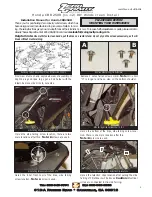
2
Safety Precautions
General Information
The installation of modules requires a great
degree of skill and should only be performed
by qualified licensed professionals, including,
without limitation, licensed contractors and
licensed electricians.
WARNING
All instructions should be read and
understood before attempting to install,
wire, operate, and maintain the module.
Contact with electrically active parts of the
module such as terminals can result in
burns, sparks, and lethal shock whether
the module is connected or disconnected.
The installer assumes the risk of all injury
that might occur during installation,
including, without limitation, the risk of
electric shock.
The modules generate DC electrical
energy when exposed to sunlight or other
light sources. Although single module
produces only a low voltage and current,
shocks and burns are still a potential
hazard.
To avoid the hazard of electric shock and
injury, cover the entire front surface of
the modules with a dense, opaque
material such as a cardboard box, during
installation and handling of the modules.
The shock hazard increases as modules
are connected in parallel, producing higher
current, and as modules are connected in
series, producing higher voltages.
The shock hazard increases as modules
with nominal open-circuit voltage (Voc)
in excess of 50 V, and/or modules rated
for maximum system voltage in excess of
50 V.
To avoid the hazard of electric shock,
work only in dry conditions, with dry
modules and dry tools.
Do not stand or step on a module
to
avoid the hazard of injury and
damage to
the module.
Do not puncture or damage the back
sheet of a module, to avoid the hazard
of electric shock and fire.
To avoid the hazard of electric shock and
injury, children and unauthorized persons
should not be allowed near the installation
of modules.
To avoid the hazard of electric shock and
injury, be sure to completely ground all
modules.
To avoid the hazard of electric shock, fire,
and injury, do not disassemble the
module, or remove any part installed by
the manufacturer.
Unauthorized persons -except for the
qualified licensed professional-should not
open the cover of the junction box to
avoid the hazard of electric shock.
Do not touch terminals while a module is
exposed to light. Provide suitable guards
to prevent you from direct contact with
30 VDC or greater to avoid the hazard
of electric shock or injury.
When carrying a module, two or more
people should carry it by its frame and
wear non-slip gloves (to avoid injury by
a slipping module, to a foot, or cuts by
the edge of a frame, and so on).
Do not carry a module by its wires or
junction box, to avoid the hazard of
electric shock, injury or damage to the
module.
Do not drop anything on the surfaces of
a module, to avoid the hazard of electric
shock, injury, and damage.
To avoid the hazard of electric shock and
fire, be sure that all other system
components are compatible, and they do
not subject the module to mechanical or
electrical hazards.
Since sparks may occur, do not install
the module where flammable gases or
vapors are present.
Never leave a module unsupported or
unsecured.
Do not drop a module.
Do not use or install broken modules to
avoid the hazard of fire, electric shock,
and injury.
Do not artificially concentrate sunlight on
a module to avoid the hazard of fire or
damage.
Do not touch the junction box terminals
to avoid the hazard of electric shock and
injury.
Do not change the wiring of bypass
diodes to avoid the hazard of electric
shock and injury.
Do not disconnect terminals while modules
generate electricity and connect electrical
load to avoid the hazard of electrical
shock.
Do not touch a module unnecessarily.
The glass surface and frames get hot.
There is a risk of burn.
CAUTIONS
Use a module for its intended purpose
only.
Do not treat the back sheet or front
surface with paint or adhesives, to avoid
reducing its’ functionality, damage,
inoperable conditions, and other unknown
troubles.
GENERAL SAFETY
Follow all permissions, installation and
inspection requirements.
Before installing modules, contact the
appropriate authorities to determine
permissions, installation and inspection
requirements, which should be followed.
Be sure that the construction or structure
(roof, etc.) where the modules are
being installed has enough strength.
For modules mounted on roofs, special
construction or structures may be required
to help provide proper installation support.
Both roof construction and module
installation design have an effect on the
fire resistance of a building. Improper
installation may contribute to fire hazards.
Additional devices such as ground fault,
fuses, and disconnects may be required.
Do not use modules of different
specifications in the same system.
Follow all safety precautions of other
system components used.
INSTALLATION
General
Please read this guide completely before
installation or use of the modules. This
section contains electrical and mechanical
specifications needed before using your
Panasonic PV modules.
Modules should be firmly fixed in place in
a manner suitable to withstand all
expected loads, including wind and snow
loads.
Modules use anti-reflection glass. Surface
of the glass is easy to be soiled, when
it is grasped by hand or hand globes. It
is recommended to hold cardboard or
frames when carrying or installing the
solar panel. When cables and connectors
touch hardly with surface of the glass, it
may soil the surface too. It is also
recommended to avoid contact of cable
and connectors with surface of the glass.
(If the glass surface becomes dirty, see
section of anti-reflection glass surface
cleaning.)
For a non-integral module or panel, the
assembly is to be mounted over a fire
resistant roof covering rated for the
application.
Appropriate material should be used for
mounting hardware to prevent the module
frame, mounting structure, and hardware
itself from corrosion.
Install modules where they are not
shaded by obstacles like buildings and
trees. Especially pay attention to avoid
partially shading the modules by objects
during the daytime.
Please contact your Panasonic Authorized
Representative with questions regarding
mounting profiles for modules if needed.



























